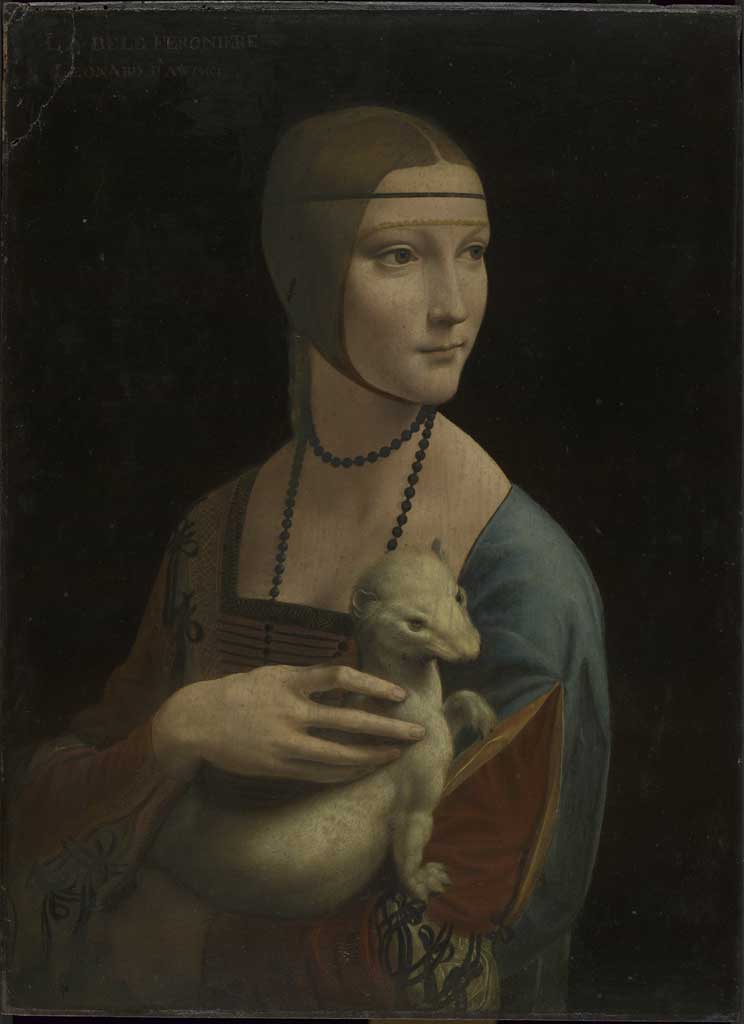Great Works: Portrait of Cecilia Gallerani (The Lady with an Ermine) 1489-90 (54.8cm x 40.3cm), Leonardo da Vinci
National Museum, Cracow

This young Renaissance lady – more tricked-out girl than lady – is cradling something savage, and this fact rather troubles us. Is she at ease with this creature? What is it there for? We think forward immediately to Holbein's great portrait of a woman with a squirrel and a starling, painted almost 40 years after this one, and we ponder upon the fact that Holbein's tenderly preoccupied red squirrel, also perched on the forearm, looked so much more benign than this perkily rampant creature, whose head is rearing up and away from the upper arm of this rather taut looking young woman.
And then we think of yet another artwork, a photograph this time, by the outrageous Robert Mapplethorpe, snapped in 1982. It shows a very cheeky old lady called Louise Bourgeois, half-cradling, half trapping beneath her arm, a giant penis called Fillette. Fillette her (his?)self was a work of 1982. What a smirk she has on her face! But is it appropriate to set these two images, hundreds of years apart, side by side? Is the lithe, muscular body of Leonardo's creature penile at all? Would Leonardo have gone in for this sort of a joke at the expense of a famous man whose court painter he would shortly become? Perhaps not.
And yet there must be more to this than a beautiful young woman and a risqué pet of sorts. Leonardo, being the subtle and clever man that he was, would not have been satisfied with a paucity of symbolic associations. Cecilia Gallerani was about 15 years old and already the mistress of Ludovico Sforza, when Leonardo, recently arrived with his lyre in Milan, painted her. The familiar name of this painting tells us that this rampant, heraldic-looking creature is an ermine – which is, of course, a stoat in its white winter jacket.
That name, ermine, lullingly bi-syllabic, sounds more precious and cherishable than the word stoat, which is rougher, more cruel, more trenchantly out of doors, swifter with tooth and claw. Ermine fur was precious stuff, soft to the touch. Painters sometimes depicted the Virgin Mary in an ermine-lined cloak. There were also of course other beguiling tales swirling around this creature that Leonardo would surely have known and taken satisfaction in. The ermine lived in horror of soiling its winter jacket, it was said. In fact, it died if it did so. It was therefore regarded as an emblem of purity and even chastity. And so we easily shift from the idea of ermine to the idea of the purity of the young lady herself. She too was pure as the driven snow, hem hem. And then there is her own surname to take into account. Its first two syllables are the same as the Greek word for weasel or ermine...
Is this really only an ermine though? It looks more composite than that, as if Leonardo has assembled it from bits and pieces of others animals that he has been busy drawing over the years. We can see some of those wonderful drawings in the current exhibition at the National Gallery – the head of a boar, the paw of a dog. (We can also see an ermine being beaten to death by a hunter).
The pleasing shock is to look from one to the other, from girl to ermine and back again. From the restless, squirming rampancy of the wild creature to the composure of the beautifully adorned girl. The girl's bony right hand, just a little too large than it ought to be, seems to be holding the creature back, to be pinching it in by the neck. How secure is its body, curled back as it is along her forearm? The creature looks heraldic, as if it is in part a device on a shield or a coin. It sprawls, strains somewhat. Its body seems to be swimming gracefully backwards, turning as it goes, against the thrust of her – again, slightly over-large - forearm. The girl, by comparison, looks perfectly self-contained within herself.
She is the mistress of all she surveys. Which is what, exactly? We do not know what it is she is looking at askance, head twisted to the side, so intently, with just a hint of a smile. We admire the quality of her attentiveness. It is as if she is being presented to us a female model of perfectly settled intellectual engagement. Perhaps Leonardo is hinting at this: that such an intellect is well placed to tame the savagery that forever paws at one's sleeve. Has she spoken? Could she be about to speak? Those lips might suggest as much. The way in which her hair has been contained within, and curiously shaped by, no less than two thin veilings of fabric helps to define the near-perfect shape of her skull.
ABOUT THE ARTIST
Leonardo da Vinci (1452-1519), Florentine inventor, painter, architect, sculptor, draughtsman, town planner, writer, musician and inscrutable penman, was born the son of a mere notary. He trained under Andrea Verrocchio, and came under the patronage of Lorenzo de Medici. His years in Milan, where he served as court painter to Ludovico Sforza, were some of his most productive. In spite of his extraordinary reputation, he left relatively few fully authenticated paintings to remember him by.
Join our commenting forum
Join thought-provoking conversations, follow other Independent readers and see their replies
Comments